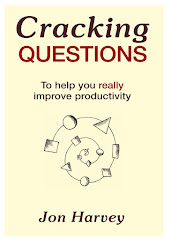However, there is likely to still be a pervasive and resilient culture that naturally favours buying products and services from larger corporations. As the PM stated on 11/2/11, there is still a culture of ‘nobody gets sacked for buying an IBM’. This culture is probably still so embedded as to mean that many of those involved in Government procurement will not easily make the transition to an ‘SME friendly’ culture. See here for further information: http://www.cabinetoffice.gov.uk/content/sme-contracts & my blog about the meeting in February http://jonharveyassociates.blogspot.com/2011/02/procurement-what-david-cameron-francis.html.
Whilst competition law, the need for VfM and the Civil Service Code mean that there must be no positive discrimination in favour of SME supply, there can perhaps be positive action.
This document sets out some questions designed to challenge those involved in Government procurement to manage tendering processes in ways that positively highlight the value and importance of SME provision.
Ten questions for procurement executives, advisers, officers and specialists to address in order to assure an ‘SME friendly’ procurement process and which has no implicit bias in favour of larger organisation bidders:
If you have any contributions, please either email me (jon@jonharveyassociates.co.uk) or post a comment below. I would be interested in the dialogue. Thank you
Whilst competition law, the need for VfM and the Civil Service Code mean that there must be no positive discrimination in favour of SME supply, there can perhaps be positive action.
This document sets out some questions designed to challenge those involved in Government procurement to manage tendering processes in ways that positively highlight the value and importance of SME provision.
Ten questions for procurement executives, advisers, officers and specialists to address in order to assure an ‘SME friendly’ procurement process and which has no implicit bias in favour of larger organisation bidders:
- Within our overall commissioning strategy & plan or this specific procurement exercise, have we ‘chunked’ our requirements into optimally scoped portions such that suppliers of all sizes would be able to bid?
- Within the bidding process, have we made available documentation & information from past / existing contracts (including materials produced by suppliers that we now own the IPR to plus our detailed evaluations of past delivery) to ensure that all bidders (which may include past / existing suppliers) are competing on a level playing field?
- In our efforts to ascertain whether bidders have the necessary skills & track record of performance that we require, have we a process for establishing whether the claimed experience still exists within the supplier organisations (and not merely part of a company back catalogue, the agents of which have since left the company, for example)?
- Have we specified our requirements in such a way as to allow bidders to propose innovative solutions which may look (very) different to the delivery model we had in mind (or are used to) but which may well nonetheless achieve the outcomes we are seeking with greater efficiency, effectiveness and economy?
- Have we created a set of communication mechanisms between us and potential bidders that blends and balances the need for transparency with the need for a carefully controlled confidential channel so that some bidders can request to explore certain innovative ideas which (if revealed to all) would significantly damage their advantage?
- If we are using a framework or PQQ process (and acknowledging that such methods are now seen as counter to the direction of Ministerial intentions and Government policy), are we confident that these processes do not have any inbuilt bias towards larger organisations through (e.g.) requiring voluminous (and often largely irrelevant) policies on sustainability, health & safety or international supplier QA?
- Have we requested details of financial or economic standing that are either disproportionate to the actual risk associated with that which we are procuring or indeed plainly irrelevant, and which may yield a real or psychological bias in favour of larger organisations (asking for ‘audited accounts’ for instance)?
- Within the process leading up to the publication of the tender documents or PQQ, have we ensured that the voice of the end user / customer (such as the battlefield soldier or the older person needing support) has been woven irrevocably into the very fabric of our statement of requirements so that we can be sure that bidders will shape their proposals around what these final users need and not what they (or indeed any other intermediaries) ‘think’ should be delivered?
- Whilst keeping the whole commissioning and procurements processes clean and lean, have we built in an opportunity for an independent “SME advocate” to challenge and scrutinise us so that we can be sure that the overall tender procedure contains no hidden biases in favour of larger organisations?
- Have we put in place an evaluation framework so that we can independently verify that the best bidder was eventually chosen from amongst all those who showed an initial interest and (possibly, though this would be hard to achieve) those who might have bid but for their being generally put off by the scope of Government procurement, without being tautologically attached to believing that our bidding processes always identifies the best bid?
If you have any contributions, please either email me (jon@jonharveyassociates.co.uk) or post a comment below. I would be interested in the dialogue. Thank you








.jpg)



No comments:
Post a Comment